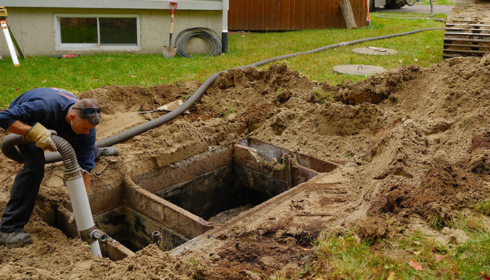A septic system rarely fails without giving hints first, but those hints often blend into everyday home frustrations and get brushed off too long. Field failure, once it starts, becomes expensive, disruptive, and avoidable with early action. Recognizing the difference between a small plumbing annoyance and a system under pressure is what protects the yard, the pipes, and the wallet.
Slowed Draining Spreading Beyond a Single Fixture
A single clogged sink usually points to a localized blockage, not a system threat. Trouble starts when multiple drains slow down together—tubs, showers, and bathroom sinks clearing slower by the week. That pattern means wastewater is not exiting the property at the rate it should, a classic early indicator that septic tanks are filling beyond healthy capacity.
Drain speed tends to worsen gradually at first, making it harder to detect until daily routines feel interrupted. Homes overdue for septic tank pumping see this more often because solid waste buildup limits flow through the outlet baffle. Acting early prevents pressure from shifting into the drain field, where repairs become far more complicated.
Gurgling Sounds Traveling Through Household Plumbing Lines
Random gurgles that echo through pipes are not “normal house noises.” These sounds form when air pockets fight for space inside plumbing due to restricted wastewater movement. It often happens after flushing, running a washing machine, or draining the bathtub—points where water volume surges through the system quickly.
The sound itself doesn’t cause damage, but it signals imbalance below the surface. Gurgling suggests the tank is struggling to process incoming waste and vent properly. Systems approaching failure often produce louder, more frequent sounds, especially when septic tank pumping is long overdue.
Pooled Water Forming Above the Drain Field Zone
Standing water appearing in a yard without visible irrigation lines or poor grading raises alarms instantly for septic professionals. The drain field exists to filter liquid waste underground, not sit above ground in puddles. When pooling begins, it usually means the soil is no longer absorbing effluent at the necessary pace.
Oversaturation forces untreated water upward, bringing biological contaminants with it. This is not the same as a muddy area after rain—it’s typically localized, slow to evaporate, and paired with soft spongy ground. In cases like this, septic tank cleaning becomes urgent to stop field collapse.
Sudden Lawn Saturation That Isn’t Tied to Rainfall
A lawn that stays unusually green, thick, or wet when surrounding areas look dry can be visually misleading. The change may appear positive at first, resembling natural fertilization, but it actually signals wastewater reaching the surface soil layer. Excess nutrients from a stressed system can accelerate grass growth above the field line.
Over time, the ground takes on a consistently damp texture, even during dry stretches. This hidden saturation creates long-term damage to soil composition and limits oxygen flow needed for waste filtration underground. Without septic tank pumping in Huntsville AL services at this stage, field lines risk permanent clogging.
Persistent Odor Tracing Back to Outdoor Tank Access Points
Septic systems are sealed environments—strong outdoor odor is a sign those seals are being tested. Foul smells near risers, inspection caps, or the general tank zone mean gases are not venting through intended pathways. The source could be rising solid layers, blocked plumbing vents, or pressure buildup inside the tank itself.
The odor tends to intensify during temperature swings when gas expansion accelerates. This is different from brief smells that disappear after rainfall or landscaping work. Persistent odor usually means bacterial balance is off and sludge volume is near its limit, requiring immediate septic tank pumping for system stability.
Sewage Backup Appearing at the Lowest Drains in the Home
Water seeks the lowest exit point when systems overload. That is why backups often show in floor drains, basement bathrooms, or first-level tubs before any upstairs fixtures are affected. These incidents are not random; they mean outbound waste is meeting resistance and reversing direction.
At this stage, the tank can no longer act as a buffer or holding chamber, and liquids are pushing back into the structure. Quick pumping can stop progression, but delays may lead to wastewater entering living spaces. This is one of the clearest danger signs that septic tank cleaning should not wait another day.
Noticeable Rise in Sludge Levels During Routine Tank Checks
Visual inspections offer the most direct insight into system health. A rapid rise in sludge or scum levels between scheduled service intervals means the tank is processing faster than it can disperse, or the household load has changed significantly. Measurements nearing the outlet pipe height are red alerts for pump timing.
Smart monitoring prevents guesswork. Solids near the baffle increase the chance of waste entering the drain field, where damage becomes irreversible. Regular inspection combined with timely septic tank pumping protects the field’s longevity and avoids trench or line replacement.
System awareness saves property owners from preventable breakdowns and long restoration timelines. For homes and commercial properties relying on underground waste systems, earlier action always beats emergency intervention. Professional evaluations and pump scheduling by teams experienced in septic service and land preparation—like those at Cora Landscape—can keep the entire system working as designed.

